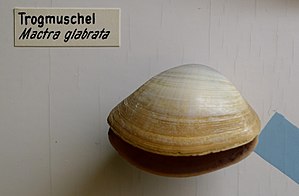Mactra glabrata
| Mactra glabrata | ||||||||||||
|---|---|---|---|---|---|---|---|---|---|---|---|---|

Mactra glabrata |
||||||||||||
| Systematics | ||||||||||||
|
||||||||||||
| Scientific name | ||||||||||||
| Mactra glabrata | ||||||||||||
| Linnaeus , 1767 |
Mactra glabrata is a type of mussel from the family of trough mussels (Mactridae). It is native to the shallow waters of the eastern Atlantic from the south of the Iberian Peninsula to South Africa and some archipelagos in this part of the Atlantic.
features
The equally hinged housing is between 3 and 5.5 cm long. It is very distended and roughly triangular to ovoid in outline. Nordsieck gives a ratio of length to height to thickness of 50/36/19 (mm). The vertebra is badly distended and large. and sits roughly in the center line of the case. The posterior dorsal margin is straight and slopes steeply. The rear end is angled. The anterior dorsal margin is very slightly convex, sloping a little flatter, and the anterior end is rounded. The ventral margin is well arched. The case gapes only a little at the back. The lock of the left valve consists of three main or cardinal teeth plus an anterior and posterior posterior tooth. The two main front teeth form a lambda-shaped structure. The third cardinal tooth is small. The right valve has two main teeth which are arranged at an angle to each other, the front one is almost parallel to the dorsal margin. and two anterior and posterior posterior teeth.
The ligament is divided into two parts. The outer dark brown ligament sits as a thin, sunken band behind the vertebrae, the inner ligament sits on a spoon-shaped extension of the shell ("chondrophor") under the vertebra. A small, thin, cream-colored, chalky septum divides the inner and outer ligaments. The lunula is heart-shaped and somewhat deepened. The area is flat. The surface line is indented moderately deep.
The ornamentation consists of fine growth strips parallel to the edge, which become even finer towards the vertebra; the housing is almost smooth in the vertebral area. The surface shines through this very fine ornamentation. The shell is pale brown on the outside with lighter zones and some dark rays that run in the rear half of the case from the vortex to the edge of the case. The inside is whitish with a purple tint. The periostracum is a thin, yellowish coating.
The siphons are united and covered by a layer of tissue.
Similar Art
The housing of Mactra glabrata is somewhat longer (in relation to the height) and also more distended (thicker) compared to the radiation basket ( Mactra corallina ). On the dorsal side there are concentric grooves, often also on the front end, color similar to M. corallina
Geographical distribution and habitat
The range of the species extends from Morocco along the West African coast to Angola and South Africa . It is also found in the waters around the Canary and Cape Verde Islands .
It lives on sandy soils in water depths of 15 to 35 meters.
Taxonomy
The species was first described by Carl von Linné in 1767. Today it is generally recognized as a valid species.
literature
- S. Peter Dance, Rudo von Cosel (arrangement of the German edition): The great book of sea shells. 304 p., Verlag Eugen Ulmer, Stuttgart, 1977 ISBN 3-8001-7000-0 (p. 285)
- Fritz Nordsieck : The European sea shells (Bivalvia). From the Arctic Ocean to Cape Verde, the Mediterranean Sea and the Black Sea. 256 p., Gustav Fischer Verlag, Stuttgart 1969 (p. 141)
Individual evidence
- ^ Carl von Linné: Systema naturæ, Tom. I. Pars II. Editio duodecima reformata. P. 533–1327, Holmia / Stockholm, Salvius, 1767. Online at Göttingen Digitization Center (p. 1125)
- ^ MolluscaBase: Mactra glabrata Linnaeus, 1767